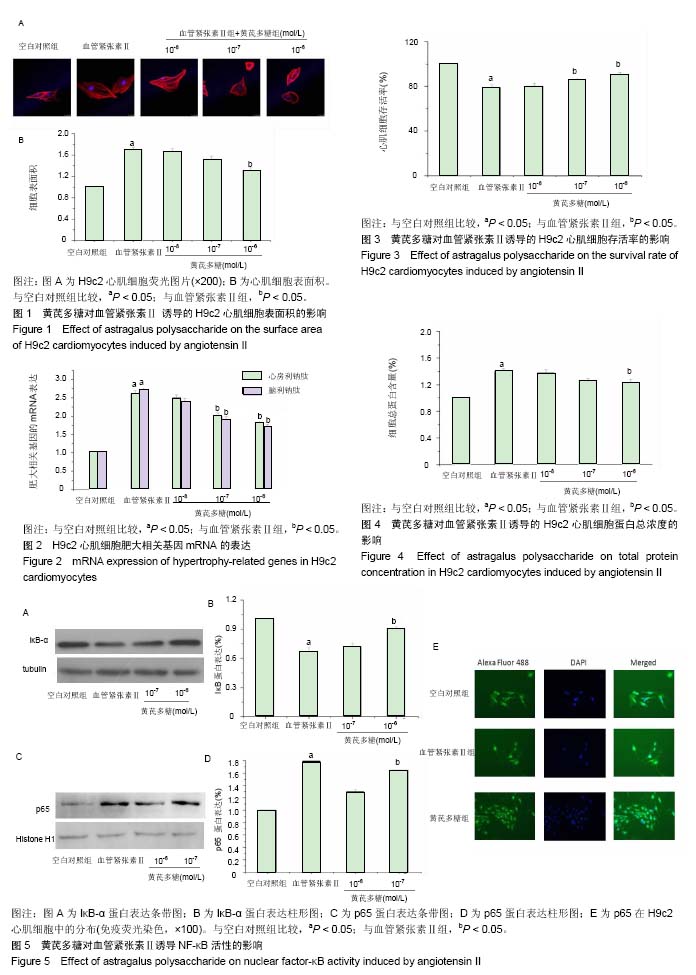| [1] 马丽媛,吴亚哲,王文陈,等.《中国心血管病报告2017》要点解读[J].中国心血管杂志,2018,23(1):3-6.[2] Hirota H,Chen J,Betz U A K,et al.Loss of a gp130 cardiac muscle cell survival pathway is a critical event in the onset of heart failure during biomechanical stress.Cell.1999;97(2): 189-198.[3] 许志威,吴伟康.心肌肥大?凋亡?纤维化?——高血压心肌肥厚中心肌重塑机制[J].中山大学研究生学刊,2005,26(1):9-20.[4] Molkentin JD, Lu JR, Antos CL,et al.A calcineurin-dependent transcriptional pathway for cardiac hypertrophy.Cell. 1998; 93(2):215-228.[5] Shah BH, Catt KJ.A central role of EGF receptor transactivation in angiotensin II-induced cardiac hypertrophy. Trends Pharmacol Sci. 2003;24(5):239-244.[6] 符民桂,唐朝枢.心肌肥大的细胞信号转导机制[J].基础医学与临床,2000,20(3):1-4+9-96.[7] Lyon RC, Zanella F, Omens JH,et al .Mechanotransduction in Cardiac Hypertrophy and Failure. Circ Res. 2015;116(8): 1462-1476.[8] 魏巍,付守廷,李少杰.血管紧张素Ⅱ致心肌肥大及机制[J].中南药学,2005,3(1):41-42.[9] Pei JF, Yan YF, Tang X,et al.Human paraoxonase gene cluster overexpression alleviates angiotensin II-induced cardiac hypertrophy in mice. Sci China Life Sci. 2016;59(11): 1115-1122.[10] Fujishima Y, Maeda N, Matsuda K, et al.Effect of adiponectin on cardiac β-catenin signaling pathway under angiotensin II infusion. Biochem Biophys Res Commun. 2014;444(2): 224-229.[11] 赵素玲,王洪新,周振华,等.黄芪多糖对异丙肾上腺素诱导的乳大鼠心肌细胞肥大的保护作用[J].中国药理学通报, 2011,27(12): 1682-1686.[12] 姚红旗,侯雅竹,王贤良,等.黄芪心血管药理作用研究进展[J].河南中医,2019,38(2):302-306.[13] 张瓅方,高丽,李超,等.黄芪丹参配伍提取物对大鼠心肌梗死后心室重构的影响[J].科学技术与工程,2018,18(30):145-149.[14] 孙敏,吴国泰,杜丽东,等.黄芪在心血管系统方面的药理活性研究进展[J].甘肃中医药大学学报,2018,35(5):91-94.[15] 范宗静,谢连娣,崔杰,等.黄芪多糖后处理通过抑制线粒体损伤介导的凋亡保护心肌缺血再灌注损伤[J].辽宁中医杂志, 2018, 45(7):1357-1360.[16] 秦琦,李文杰,杨莺,等.中药对大鼠心肌细胞凋亡影响的Meta分析[J].中西医结合心脑血管病杂志,2018,16(19):2766-2773.[17] 梁灵君,王洪新,孙雪芳,等. Toll 样受体 4/NF-κB 信号通路参与黄芪多糖对肿瘤坏死因子α诱导的乳大鼠心肌细胞肥大的抑制作用[J].中国药理学与毒理学杂志,2013,27(2):44-49.[18] Luan A,Tang F,Yang Y,et al.Astragalus polysaccharide attenuates isoproterenol-induced cardiac hypertrophy by regulating TNF-α/PGC-1α signaling mediated energy biosynthesis. Environ Toxicol Pharmacol. 2015 ;39(3): 1081-1090.[19] 芦新,杨波.黄芪多糖对心肌细胞缺氧复氧过程中细胞损伤、线粒体途径凋亡的影响[J].海南医学院学报, 2017,23(24): 3338-3341.[20] Harvey PA, Leinwand LA. The cell biology of disease: Cellular mechanisms of cardiomyopathy. J Cell Biol. 2011;194(3): 355-365.[21] Marian AJ,Roberts R. The molecular genetic basis for hypertrophic cardiomyopathy. J Mol Cell Cardiol. 2001;33(4): 655-670.[22] Zhou N, Li L, Wu J, et al.Mechanical stress-evoked but angiotensin II-independent activation of angiotensin II type 1 receptor induces cardiac hypertrophy through calcineurin pathway. Biochem Biophys Res Commun. 2010;397(2): 263-269. [23] Fu J, Wang Z, Huang L, et al.Review of the botanical characteristics, phytochemistry, and pharmacology of Astragalus membranaceus (Huangqi). Phytother Res. 2014; 28(9):1275-1283.[24] 薛善乐,严智慧,杨珊莉,等.基于证候积分——黄芪剂量关系应用补阳还五汤治疗缺血性卒中临床观察[J/OL].中医药临床杂志, 2019,31(1):123-126.[25] 闵清,白育婷,余薇,等.黄芪多糖对乳鼠心肌细胞缺氧/复氧损伤的保护作用[J].中国药理学通报, 2010, 26(12):1661-1664.[26] 郑敏,杨宏杰,张丹,等.黄芪提取液清除自由基的实验研究[J].山东中医志,2004,23(12):743-745.[27] Baldwin Jr AS. The NF-κB and IκB proteins: new discoveries and insights. Annu Rev Immunol. 1996;14:649-681.[28] 刘怡雯.核因子κB与肥厚性心肌病关系的研究进展[J].中国分子心脏病学杂志,2004,1(4):48-51.[29] 王丹阳,朱广瑾,徐成丽.NF-κB 在某些心血管疾病中的作用[J].基础医学与临床,2011,31(9):1070-1073.[30] Hall G,Hasday JD,Rogers TB.Regulating the regulator: NF-κB signaling in heart. J Mol Cell Cardiol. 2006;41(4):580-591.[31] Ogata T,Miyauchi T,Sakai S,et al.Myocardial fibrosis and diastolic dysfunction in deoxycorticosterone acetate-salt hypertensive rats is ameliorated by the peroxisome proliferator-activated receptor-alpha activator fenofibrate, partly by suppressing inflammatory responses associated with the nuclear factor-kappa-B pathway. J Am Coll Cardiol. 2004;43(8):1481-1488. |
.jpg) 文题释义:
血管紧张素Ⅱ:是肾素-血管紧张素系统的主要活性肽,通过与特异性受体结合,对心血管结构和功能产生影响,是重要的促心肌肥大因子。AngⅡ可通过内分泌、自分泌/旁分泌以及胞内分泌发挥作用,作为一种 Gq 蛋白激动因子,它已经被证明能够在多种模型中诱导肥大反应。
黄芪多糖:是从黄芪中分离得到的一种大分子化合物,是黄芪的主要活性成分,具有增强心肌收缩力、改善心肌供血和心肌代谢的药理学作用。
文题释义:
血管紧张素Ⅱ:是肾素-血管紧张素系统的主要活性肽,通过与特异性受体结合,对心血管结构和功能产生影响,是重要的促心肌肥大因子。AngⅡ可通过内分泌、自分泌/旁分泌以及胞内分泌发挥作用,作为一种 Gq 蛋白激动因子,它已经被证明能够在多种模型中诱导肥大反应。
黄芪多糖:是从黄芪中分离得到的一种大分子化合物,是黄芪的主要活性成分,具有增强心肌收缩力、改善心肌供血和心肌代谢的药理学作用。.jpg) 文题释义:
血管紧张素Ⅱ:是肾素-血管紧张素系统的主要活性肽,通过与特异性受体结合,对心血管结构和功能产生影响,是重要的促心肌肥大因子。AngⅡ可通过内分泌、自分泌/旁分泌以及胞内分泌发挥作用,作为一种 Gq 蛋白激动因子,它已经被证明能够在多种模型中诱导肥大反应。
黄芪多糖:是从黄芪中分离得到的一种大分子化合物,是黄芪的主要活性成分,具有增强心肌收缩力、改善心肌供血和心肌代谢的药理学作用。
文题释义:
血管紧张素Ⅱ:是肾素-血管紧张素系统的主要活性肽,通过与特异性受体结合,对心血管结构和功能产生影响,是重要的促心肌肥大因子。AngⅡ可通过内分泌、自分泌/旁分泌以及胞内分泌发挥作用,作为一种 Gq 蛋白激动因子,它已经被证明能够在多种模型中诱导肥大反应。
黄芪多糖:是从黄芪中分离得到的一种大分子化合物,是黄芪的主要活性成分,具有增强心肌收缩力、改善心肌供血和心肌代谢的药理学作用。
.jpg) 文题释义:
血管紧张素Ⅱ:是肾素-血管紧张素系统的主要活性肽,通过与特异性受体结合,对心血管结构和功能产生影响,是重要的促心肌肥大因子。AngⅡ可通过内分泌、自分泌/旁分泌以及胞内分泌发挥作用,作为一种 Gq 蛋白激动因子,它已经被证明能够在多种模型中诱导肥大反应。
黄芪多糖:是从黄芪中分离得到的一种大分子化合物,是黄芪的主要活性成分,具有增强心肌收缩力、改善心肌供血和心肌代谢的药理学作用。
文题释义:
血管紧张素Ⅱ:是肾素-血管紧张素系统的主要活性肽,通过与特异性受体结合,对心血管结构和功能产生影响,是重要的促心肌肥大因子。AngⅡ可通过内分泌、自分泌/旁分泌以及胞内分泌发挥作用,作为一种 Gq 蛋白激动因子,它已经被证明能够在多种模型中诱导肥大反应。
黄芪多糖:是从黄芪中分离得到的一种大分子化合物,是黄芪的主要活性成分,具有增强心肌收缩力、改善心肌供血和心肌代谢的药理学作用。